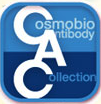 CAC Antibody Collection
CAC Antibody Collection
The antibodies on this page are part of Cosmo Bio's exclusive CAC Collection. For many many thousands of other antibodies from many different makers, use our Search the Store function and our Explore Products drop down menu.
| Product name (click for order info) | Cat No (click for datasheet) |
Host | Species specificity |
| Anti Tyrosine-Protein Phosphatase Non-Receptor Type 6 (SHP-1) pAb (Rabbit, Antiserum) | CAC-TNL-002-SH1 | RAB | RT |
| Anti Tyrosine-Protein Phosphatase Non-Receptor Type 6 (SHP-1) Phospho Tyr536 pAb (Rabbit, Antiserum) | CAC-TNL-002-SH2 | RAB | RT |
| Product name | Anti Tyrosine-Protein Phosphatase Non-Receptor Type 6 (SHP-1) pAb (Rabbit, Antiserum) |
| Cat No | CAC-TNL-002-SH1 |
| Description | SHP1 belongs to the family of protein tyrosine phosphatases (PTPs), which dephosphorylate phosphotyrosyl residues in proteins that are phosphorylated by protein tyrosine kinases. PTPs and protein tyrosine kinases function in a variety of cellular processes, from cell survival to proliferation, differentiation, migration, and immune responses. SHP1 (PTPN6) and SHP2 (PTPN11) are closely related non–receptor-type PTPs, each having two Src homology 2 domains N-terminal to the phosphatase catalytic domain. Although SHP2 is expressed ubiquitously, SHP1 is predominantly expressed in hematopoietic cell lineages, and it has been implicated in the regulation of a diverse range of cytokine receptors, growth factor receptors, and immunoreceptors. SHP1 has been shown to associate with ITIMs in these receptors and has been proposed to bind to ITIM-like motifs in various kinases, including IL-1R–associated kinase 1, ERK1/2, p38, JNK, JAK2, JAK3, TAK1, IκB kinase α, and LYN. [from: Kanwal Z, Zakrzewska A, Hertog Jd, Spaink HP, Schaaf MJM and Meijer AH. (2013) Deficiency in Hematopoietic Phosphatase Ptpn6/Shp1 Hyperactivates the Innate Immune System and Impairs Control of Bacterial Infections in Zebrafish Embryos. J Immunol. 190:1631-1645.] References: 1) Ozawa T, Nakata K, Mizuno K, Yakura H. (2007) Negative autoregulation of Src homology region 2-domain-containing phosphatase-1 in rat basophilic leukemia-2H3 cells. Int Immunol. (9):1049-1061. |
| Host | RAB |
| Species specificity | RT |
| Product name | Anti Tyrosine-Protein Phosphatase Non-Receptor Type 6 (SHP-1) Phospho Tyr536 pAb (Rabbit, Antiserum) |
| Cat No | CAC-TNL-002-SH2 |
| Description |
SHP1 belongs to the family of protein tyrosine phosphatases (PTPs), which dephosphorylate phosphotyrosyl residues in proteins that are phosphorylated by protein tyrosine kinases. PTPs and protein tyrosine kinases function in a variety of cellular processes, from cell survival to proliferation, differentiation, migration, and immune responses. SHP1 (PTPN6) and SHP2 (PTPN11) are closely related non–receptor-type PTPs, each having two Src homology 2 domains N-terminal to the phosphatase catalytic domain. Although SHP2 is expressed ubiquitously, SHP1 is predominantly expressed in hematopoietic cell lineages, and it has been implicated in the regulation of a diverse range of cytokine receptors, growth factor receptors, and immunoreceptors. SHP1 has been shown to associate with ITIMs in these receptors and has been proposed to bind to ITIM-like motifs in various kinases, including IL-1R–associated kinase 1, ERK1/2, p38, JNK, JAK2, JAK3, TAK1, IκB kinase α, and LYN. [from: Kanwal Z, Zakrzewska A, Hertog Jd, Spaink HP, Schaaf MJM and Meijer AH. (2013) Deficiency in Hematopoietic Phosphatase Ptpn6/Shp1 Hyperactivates the Innate Immune System and Impairs Control of Bacterial Infections in Zebrafish Embryos. J Immunol. 190:1631-1645.] References: |
| Host | RAB |
| Species specificity | RT |
